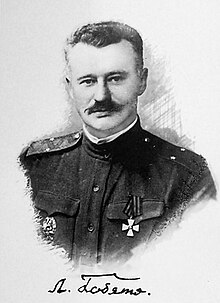Leonid Gobyato
This articleneeds additional citations forverification.(March 2013) |
Leonid Nikolaevich Gobyato | |
|---|---|
 Leonid Gobyato in 1916 | |
| Native name | Леонид Николаевич Гобято |
| Born | 6 February 1875 Taganrog,Russian Empire |
| Died | 21 May 1915(aged 40) Przemyśl,Austria-Hungary |
| Allegiance | |
| Service/ | Imperial Russian Army |
| Years of service | 1876–1915 |
| Rank | Lieutenant General |
| Battles/wars | Russo Japanese War World War I† |
| Awards | |
Leonid Nikolaevich Gobyato(‹See Tfd›Russian:Леонид Николаевич Гобято;6 February 1875 – 21 May 1915) was alieutenant-general(awarded posthumously in 1915) in theImperial Russian Armyand designer of the modern, man-portablemortar.
Life and career
[edit]Gobyato was born in the city ofTaganroginto the noble family of Gobyato. His father, Nikolai Konstantinovich Gobyato, was a gentleman by birth, member of the Taganrog County Court and alderman at the Taganrog City Council (Duma). Gobyato graduated from theChekhov Gymnasiumin Taganrog, afterwards studying at theCadets CorpsinMoscowand in 1893, was recommended as one of the best student to the Mikhailovskoe Artillery School from which he graduated in 1896. He then attended theMikhailovskoe Artillery Academy,from which he graduated in 1902.
In May 1902, Gobyato returned to the home city of Taganrog, where in 1903 he submitted his first workInstructions on Use of Deflection in Batteries Equipped with 3-inch Rapid-Firing Guns of 1902,written in cooperation with Colonel Demidov.
After the outbreak of theRusso-Japanese Warof 1904–1905, both Leonid and his brother Nikolai were participating in the events. Nikolai served on theRussian Navy's cruiserGromoboibased with theRussian Pacific FleetatVladivostok,while Leonid, with the rank of captain, was a battery commander in the 4th East Siberian Rifle Artillery Brigade based atPort Arthur.At the Battle of Jinzhou, Leonid Gobyato, together with GeneralRoman Kondratenko,for the first time appliedindirect firefrom closed firing positions in the field using a protractor. In July 1904, he was seriously wounded in the thigh in combat, and was assigned to be assistant chief of artillery of the Port Arthur fortress. During theSiege of Port Arthur,the fighting revealed the need for a weapon to attack the Japanese in closely spaced trenches, gullies and ravines. Together with Russian navymidshipmanS. Vlasov, he modified smallnaval mineswith stabilizers be fired from a wheeled 47-mm navalmortar.For services in the defense of Port Arthur was awarded five medals (among them theOrder of St. George(4th degree)[1]and the Golden Sword "for courage". After the surrender of the garrison of Port Arthur on January 2, 1905, Gobyato was made aprisoner of war.
After his return from captivity in May 1906, Gobyato was promoted and published an article on his first mortar ( "Fighting the principles and rules of Field Artillery" ). In early 1908, he graduated from Officer's Artillery School and in September of the same year was assigned to command the 3rd Battery of the 3rd Artillery Brigade. He also served as a lecturer on artillery science at theGeneral Staff Academyfrom 1908 to 1914.
After the outbreak ofWorld War I,Gobyato was made commander of 32nd Artillery Brigade, followed by the 35th Artillery Brigade. He was promoted to major general on August 14, 1914. However, while leading an infantry counter-attack at theSiege of Przemyślin what is now part ofPoland,he was killed in combat on May 21, 1915. His grave is at the Gobyato family estate outside ofRyazan.
-
Birth house of Gobyato inTaganrog.
-
A shell for the Gobyato's mortar, 1904
-
Gobyato's mortar, 1904
-
The scheme of the shell for the Gobyato's mortar (from theAlferaki Palacein Taganrog)
See also
[edit]References
[edit]- ^Гаврюшкин О. "По старой Греческой", Таганрог, 2003 г.
- 1875 births
- 1915 deaths
- Military personnel from Taganrog
- People from Yekaterinoslav Governorate
- Inventors from the Russian Empire
- Imperial Russian Army generals
- Untitled nobility from the Russian Empire
- Military engineers of the Russian Empire
- Russian military personnel of the Russo-Japanese War
- Russian military personnel killed in World War I




